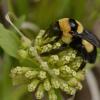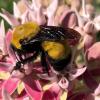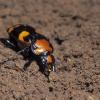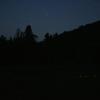(Diptera: Brachycera: Asiloidea: Mydidae)
This unique species, native to the Inland Empire of southern California, is on the brink of extinction as the irreplaceable habitat it calls home disappears. The Delhi Sands flower-loving fly is the first and only fly to be listed under the Endangered Species Act. Scientists petitioned the species in 1990 and the U.S. Fish and Wildlife Service listed it as endangered in 1993.
The Delhi Sands habitats are highly unusual and are not found anywhere else on earth. Protection of the fly is important, in part, because it will protect many other species also living in the dunes. These dunes support birds like the western meadowlark and the burrowing owl, mammals like the Los Angeles pocket mouse, a tiny buff-colored creature that fits easily in the palm of your hand, insects such as a subspecies of the Mormon metalmark butterfly (Apodemia mormo nigrescens), as well as numerous reptiles and plants. Scientists have compared the Delhi Sands flower-loving fly to a flagship for the whole Delhi Sands ecosystem: “As long as the fly stays afloat, the rest of its habitat does, too,” said Greg Ballmer of UC Riverside.
Like butterflies, honeybees and other pollinators, the Delhi Sands flower-loving fly feeds on nectar from flowers. Like hummingbirds, these remarkable flies are rapid fliers that hover over flowers while taking nectar. One of the largest flies, this one-inch long insect is orange-brown and black with dark brown oval spots. During July through September, adult flies feed, mate and lay eggs in the sandy soil.
There are around a dozen populations of this species in San Bernardino and Riverside counties, east of Los Angeles.
The flies live in fine sandy soil, known as Delhi series sand. Most of the fly’s habitat has been destroyed by development and agricultural conversion. Only about 2-3% of the habitat remains.
The Delhi Sands flower-loving fly is listed as Endangered under the U.S. Endangered Species Act.
On September 10, 2004, the U.S. House of Representatives Committee on Resources held a field hearing in Fontana, California with the ostensible purpose of gauging public support for the endangered Delhi Sands flower-loving fly. Despite their official-sounding title, this “hearing” was not the Congressional fact-finding missions that it was touted to be. Almost all of the invited speakers were against the Endangered Species Act and believe development should take precedence over protecting habitat. Several of the speakers regularly attended other meetings carrying large fly swatters.
The fly has been blamed for halting development projects in San Bernadino County, California. However, the facts show that few developments have been stopped. Furthermore, protecting the fly’s habitat preserves important open space that also hosts a variety of California’s native birds and other wildlife habitat in this fast-growing region – the open space that so many people moved to this area to enjoy.
Preserving the Delhi sand dunes preserves not only the ecosystem but also vanishing open space in the rapidly growing Inland Empire. Saving this natural heritage will enhance quality of life in this expanding urbanized region, which is deficient in natural open space.
The U.S. Fish and Wildlife Service has not yet designated critical habitat for the Delhi fly. A recovery plan for the species, finalized in September 1997, calls for the establishment of three recovery units and collaboration with private landowners to preserve and enhance habitat.
Profile prepared by The Xerces Society





